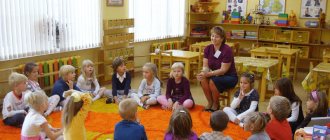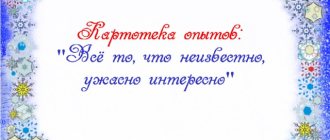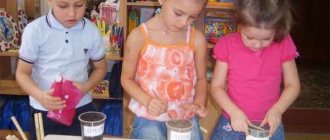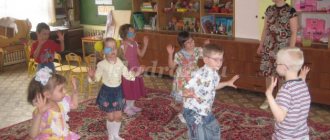Card file of experiments with water
Material: two identical measuring containers.
Children pour an equal amount of water into containers; together with the teacher they make a level mark; one jar is closed tightly with a lid, the other is left open; Both jars are placed on the windowsill.
The evaporation process is observed for a week, making marks on the walls of the containers and recording the results in an observation diary. They discuss whether the amount of water has changed (the water level has become lower than the mark), where the water from the open jar has disappeared (water particles have risen from the surface into the air). When the container is closed, evaporation is weak (water particles cannot evaporate from the closed container).
Experiment 4. Where does water come from?
Purpose: to introduce the condensation process.
Material: hot water container, cooled metal lid.
An adult covers a container of water with a cold lid. After some time, children are invited to examine the inside of the lid and touch it with their hands. They find out where the water comes from (water particles rose from the surface, they could not evaporate from the jar and settled on the lid). The adult suggests repeating the experiment, but with a warm lid. Children observe that there is no water on the warm lid, and with the help of the teacher they conclude: the process of turning steam into water occurs when the steam cools.
Experiment 5. “Water is liquid, so it can spill out of a vessel.”
Purpose: to identify the property of water: water does not have a specific shape.
Materials: glasses of water.
Place dolls at the table. Guys, it's hot outside, the dolls are thirsty. Now we will give them water.
Pour water into a glass to the top. Invite one of the children to carry the water at a brisk pace and see whether the water spilled or not. What happened to the water? (Spilled on the floor, on clothes, got my hands wet). Why did this happen? (The glass was too full). Why might water spill? (Because it is liquid). We poured our glasses too full; liquid water splashes in them and spills. How can you prevent water from spilling? Fill the glasses halfway and serve slowly. Let's try.
Conclusion: What did we learn today? What kind of water? (Water is liquid). If the glass is too full, what can happen to the water? (It may spill).
Experience 6. “Transparent water can become cloudy.”
Goal: to identify the property of water - transparency.
Materials: two glasses of clear water, flour, any item.
Pour clean water into a glass and throw an object into it. Can you see him? Good visibility? Why? (The water is clear). What's in the glass? Add a little flour to another glass of clean water, stir, and lower the object. It is seen? Why? (The water is cloudy and opaque). Can you see what's in the glass? Look at the aquarium. Is the water in it cloudy or clear? (Transparent). Can the fish see everything clearly? Look, we sprinkle food, the fish can clearly see it, they quickly swim up and eat. If the water was cloudy, the fish might have gone hungry. Why? (In muddy water it is difficult to see food.)
Progress of experimental activities
Children are asked a riddle about water
Everyone says it flows.
Everyone says she's playing.
She always runs forward
But he doesn't run away. (water)
You know, guys, water is like a sorceress from fairy tales. She can do different transformations. Would you like to become wizards together with some water? (answers)
Listen, what is this? (Audio recording of water sounds (answers)
You guessed right, it is our sorceress water who invites us to the laboratory to do magic there .
1. The teacher shows the children clean water in a transparent glass.
Guys, what kind of water do we have in our glass? (children's answers)
Experience: Place an object in a glass of water . Is he visible? Yes. Conclusion: the water is clear.
Let's take a closer look at what kind of water it is? What color is it? What colors do you know? (children's answers)
Water does not resemble any color, water has no color, which means it is colorless. Let's repeat the word “colorless” in unison.
2. But we told you that water is a magician; it turns out that it can change its color.
Experience: Each of you has a brush and gouache. I suggest you wet the brush, dip it in the gouache and stir the clear water in your glasses with the brush. What happened to the water ? (answers)
The water changed its color: for some it became yellow, for others it became green, red, blue.
We learned that water can change its color.
Experience: Compare the color of clear water with the color of multi-colored stripes. Conclusion: the water is colorless.
3. Children are given new glasses with clear, clean water .
Let's smell the water. What does she smell like? (answers)
Clean water, guys, doesn't smell like anything. The water is odorless. What do you think, does water have a smell? (answers)
What do you think the water will smell like if I put currant jam in it? (answers)
The teacher puts jam in his glass of water , stirs it and gives it to each child to smell. What does the water smell like? (answers)
4. Children have cups of clean water .
Guys, do you think water has a taste? (answers)
Let's remember what tastes we know? Candy, what does it taste like? (answers)
What does lemon taste like?
(answers)
Now try some water. What does it taste like? (answers)
Pure water has no taste; it is tasteless. Let's repeat the word "tasteless" in unison.
Well, guys, water really is magic! Let's remember, what is clean water like? (answers)
2. Without color (colorless)
3. Without taste (tasteless)
But we have found out that water has the ability to change its color, smell and taste - therefore water can be called magical.
Did you like doing magic? (answers)
Next time we will come to the laboratory again and find out what else the water sorceress can do.
Photo report “Experimenting with water” Purpose: Communication: -continue to introduce water and its properties; enrich vocabulary, develop dialogical speech. Cognition: -form.
Game-experimentation with water in an early age group 2-3 years old Video Experimenting with water in an early age group Purpose: to form in children ideas about the properties of water (transparent, flowing, alone.
Synopsis of GCD in the middle group “Experiments with water” Synopsis of direct educational activities in the middle group Topic “Experiments with water” Goal: To consolidate children’s knowledge about properties.
Experimentation lesson in the senior group “Properties of water” Cognitive development. Cognitive - research activities. Nature. Lesson - experimentation in the senior group on the topic:.
“Equipment for playing with wind, water, sand. Experimentation of preschoolers on a walk." Consultation for educators Consultation for educators On the topic: “Equipment for playing with wind, water, sand. Experimenting with preschoolers on a walk."
Open educational activity “Experiments with water” in the middle group Lesson in the middle group “Experiments with water” Goal: development of cognitive and research activity of children, development of experimentation skills.
Photo report “Experimenting with water” Experiment No. 1. “Everyone needs water.” Purpose: To give children an idea of the role of water in plant life. Progress: The teacher asks the children what will happen to them. Experimenting with water and various objects “Drowning - not drowning” Children are by nature experimenters and researchers, they are very inquisitive. We are ready to see a miracle in every little thing in life. One day we decided. Summary of the lesson “Experimenting with water” in the first junior group 1. Water can be colored Objectives: to clarify children’s knowledge about the properties of water; show how you can make water colored; cultivate a caring attitude. Experimenting with water at the preschool educational institution “Colored Ice” Goal: to introduce children to the properties of water in liquid and solid states. Objectives: • develop the ability to observe an object for some time;
Source
Summary of a lesson on experimenting with water in the middle group
Summary of the organization of research and experimental activities.
Game-experimentation “Wonderful water” Goal: Continue to form primary ideas about water: transparent, flowing, pouring, gurgling. Teach kids to express their impressions in words, compare, experiment, remember. Improve children's motor abilities. Develop curiosity, observation, cognitive activity, desire to learn new things. Develop tactile and kinetic sensations. Cultivate neatness, the ability to maintain order in a group and in the workplace, the ability to live together, use equipment and toys together; show a polite attitude towards others: say hello, say goodbye, ask for help, thank you for the service. Vocabulary work : transparent, flows, pours, murmurs, rustles, whispers, dries, evaporates. Equipment: 2 basins, 2 watering cans, foam sponges, 2 plastic bottles, small toys, 2 trays, 2 spoons - skimmers, oilcloth aprons, napkins for each child, demonstration board, water 10 l + 24 C. Methods and techniques: demonstration , examination, literary expression, comparison using different analyzers, research, conversation, encouragement, individual assistance. Preparing children: daily hygienic water procedures; acting out wash basins and nursery rhymes about water; reading the works of G. Oster “Bubbles and Puddles”; observations in nature: rainy weather, puddles, listening to the sound of rain, pouring water, drops, playing with water, transfusion. Total duration: 15 min.
Progress:
I. Organizational moment Educator: - Guys, water came to visit us, here it is (we approach a basin with warm water). - Let’s remember together the nursery rhyme “Water, water...” Water, water (palms up, waving your fingers) Wash my face (corresponding movements with your palms), So that your eyes sparkle (point with your palms at your eyes), So that your cheeks turn red (circular movements with your palms) , So that the mouth smiles (we smile), So that the tooth bites. • Where are your palms? • Here, here, here! • And your fingers live in your palms. Educator : Let's say hello to some water. - First, we greet our fingers: (we touch the water with each finger in turn, first with one hand, then with the other, then with the fingers of both hands at the same time.) - Our fingers can “run” through the water, walk. One, two, three, four, five The little fingers went out for a walk, One, two, three, four, five They hid in a fist again. (Lightly touch the surface of the water with your fingers). Big feet are walking along the road: Top-top-top-top. Little legs run along the path: Top-top-top-top. (First, with our fists, then with our fingers, we depict wide and small steps on the water). Educator : If you want, do this too: either your palm (put the entire hand in the water), then your fist (alternately squeezing and unclenching your fingers in the water).
II.
Practical activity with water 1. Let's play with some water Teacher: Fingers meet each other in the water - they rub each other. -Can you see your fingers through the water? Doesn't water interfere with seeing your hands? (Conclusion: the water is clear). Educator: Tell me, what kind of water is it? (Children's answers) - Please make fists, open your fingers slightly, make cups out of your fists. I will pour water from a watering can into your cups from your fists, and you watch what the water will do? (Leaks, drips, runs, pours out). - Unclench your fists, release some water into the basin. What did the water do to your palms? (Wetted). - Let's leave traces of your wet palms on the board. —Can you see the handprints on the board? Why? (Palms are wet). - You see, water can draw - it leaves wet marks. (If necessary, use a napkin to dry your hands). 2. Experimental activity using a plastic bottle Educator: Let's take a look and find out what else water can do. This (show) a bottle, it has a cap. The lid opens and closes. The bottle is now closed. I put a bottle in water, what does the bottle do? (Floats). - Let's unscrew the cap, put the empty bottle in the water again, what happens? - Now let’s put the bottle under water like this. (The bottle is immersed in water in different ways: horizontally, vertically, at an angle, neck down, neck up). What's happening? - Let's get a full bottle of water. Listen to the sound. What do we hear? (water gurgles). Now let’s close the lid and lower the water bottle into the water. What's happened? (The bottle sank). Conclusion: Water has weight: an empty bottle is light and floats; full - heavy and sinks). • Look how many different items I have on this platter. Let's put them in water and see what happens to them. I remind you of the rule: we take only one object, calmly lower it into a basin of water, and do not disturb other children. (Conclusion: everything that sank to the bottom and sank is heavier than water, everything that is lighter than water floats). • Now let’s collect with our hands what is floating, everything that is light and put it on the red spreader, and we will catch everything that is heavy that has sunk, take it out with a spoon like this and put it on the blue spreader. - Listen to the noise of the water that is pouring out of the bottle and the noise of the water that is pouring out of the watering can. Same? (A trickle of water murmurs, “rain” from a watering can makes noise, “rustles,” “whispers”). 3. Water transfusion Teacher: Water loves to be poured and travel. Let's help her with this. Do you agree? • Look, we have 2 basins: one with water and the other empty. Let's help the water move from one basin to another in an unusual way. (I hand out sponges to the children.) Take these sponges - washcloths in your hands, touch them, tell us what they are like. (Soft, dry). Place the sponges in a bowl of water and watch what happens to them? Take your sponge - washcloth in your hands, carefully transfer it to another basin - empty and squeeze it. What's happened? (Water is absorbed into the sponge and flows out if the sponge is squeezed). Children, while playing, transfer water from one basin to another. Educator : Well, our water has safely moved into the empty basin. Let's squeeze out our lips well and remove all the droplets and puddles from the table, put everything in order. “We completely forgot about our drawing; for some reason I don’t see it on the board.” And you? Where did our drawing of wet palms go? (Children's answer options) (Conclusion: water can dry out, which means it can evaporate.) • What else do you remember about water, what can it do? (Children's answers, results of experiments).
III. Final part Educator: Our game with water is over for today. It's time to put things in order, put everything in its place. How well done we are!
We recommend watching:
Synopsis of an integrated educational activity for familiarization with the outside world in the middle group Synopsis of an educational activity for experimentation in the middle group Synopsis of the educational activity in the middle group for OO "Cognition" with elements of experimentation Summary of a lesson on experimental experimental activities in kindergarten. Middle group
Similar articles:
Lesson summary for the middle group on the topic: Properties of glass




